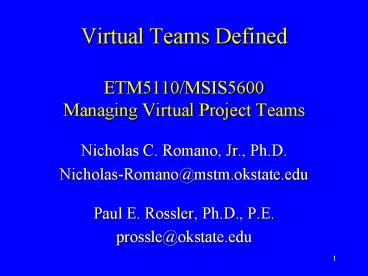Virtual Teams Defined ETM5110MSIS5600 Managing Virtual Project Teams - PowerPoint PPT Presentation
1 / 23
Title:
Virtual Teams Defined ETM5110MSIS5600 Managing Virtual Project Teams
Description:
How does a virtual team differ from traditional ... FTP/Gopher. WAIS. Boston. DC. DC. DC. SF. SF. NY. NY. HK. PIT. ATL. LA. LON. Paris. CHI. LA. SYD. 5. Same ... – PowerPoint PPT presentation
Number of Views:404
Avg rating:3.0/5.0
Title: Virtual Teams Defined ETM5110MSIS5600 Managing Virtual Project Teams
1
Virtual Teams Defined ETM5110/MSIS5600Managing
Virtual Project Teams
- Nicholas C. Romano, Jr., Ph.D.
- Nicholas-Romano_at_mstm.okstate.eduPaul E.
Rossler, Ph.D., P.E. - prossle_at_okstate.edu
2
Overview
- What is a virtual team? How does a virtual team
differ from traditional teams? - What types of virtual teams are there?
- Are virtual teams all that new?
- What driving forces have led to the rise of
virtual teams? - What do current trends in the use of virtual
teams suggest?
3
Virtual teams are
- Groups of people who work interdependently with
shared purpose - Across space, time, and organizational boundaries
- Using technology to communicate and collaborate
4
DC
NY
DC
Boston
LA
LA
SF
Paris
PIT
HK
SYD
NY
ATL
LON
DC
SF
CHI
5
A framework for thinking about teams and virtual
teams
Place
Same
Different
Same
Time
Different
6
Virtual teams can differ along a number of
dimensions
- Stability of membership (Stable, Fluid)
- Clarity of team boundaries (Unclear, Clear)
- Timeframe in which to operate (Immediate, Long
Term) - Regularity of activity (Regular, Infrequent)
7
- Type or nature of task
- (Routine, Non-routine)
- Decision making authority (None, Full)
- Complexity
- Organizational (Single, Multiple)
- Cultural
- Temporal (Single Time Zone, Multiple)
8
Example comparison of two types of virtual team
9
Virtual team management in the context of a
management system
Idea organization, prioritization, consensus,
contribution and progress
Virtual Team Leader, Members
Technology Structure Process Facilitation
Collaborative decisions and actions
Ideas Information Performance Progress
Project Problem Task
(Based on Kurstedts Management System Model)
10
An increasing number of people are participating
on virtual teams
- Downsizing/Rightsizing
- Flattening, Re-engineering
- Telecommuting
- Improvements in communication technology
- Increased Competition
- Globalization
- 9/11
11
Some recent statistics
- Two-thirds of Fortune 500 companies employ
telecommuters - 19 million people worked from their home in 2001
- The Gartner Group estimated that by 2002 over 100
million people worldwide will be working outside
traditional offices
Kirkman, B. L., et al. 2002. Five challenges to
virtual team success Lessons from Sabre, Inc.
Academy of Management Executive, 16(3) 67-79.
12
Tomorrows fragmented, geographically dispersed
workplace is increasingly becoming a space, not
a place, for many
13
The Information Age
- Manage routine transactions (50s-60s)
- Integrated business operations (70s)
- Enterprise-wide communication (80s)
- Collaborative technology (90s)
- Ubiquitous computing 2000-???
- Manage and leverage intellectual
capital
14
A shift is taking place with respect to the
critical resource
15
Intellectual Bandwidth (IB)
- The ability of an organization to bring
intellectual capital to bear when addressing a
particular issue. - A function of the success with which an
organization deploys and uses Knowledge
Management Systems and Collaborative Technology
16
4 Levels of Collaboration Capability
High
Level 4 Collaborative Work Concerted Team Effort
Level 3 Coordinated Work Coordinated Individual
Efforts
Degree of Collaborative Effort
Level 2 Communication Work Unstructured
Information Sharing
Level 1 Cumulative Work Uncoordinated
Individual Efforts
Low
17
Level 1 Cumulative Work
- Individual, uncoordinated effort toward team goal
- Team productivity is simple sum of individual
performances - Individualized Processes - Start to Finish
- Office Applications
- MSWord Group Editing
- Multiple Spreadsheet Sections
- PowerPoint Presentation Passing
18
Level 2 Communications Work
- Unstructured information sharing
- Ad hoc process
- Information sharing applications
- Lotus NOTES Discussions
- Net Meeting
- Video Teleconferencing
- Application Sharing (Proshare)
- Chat, News Groups
19
Level 3 Coordinated Work
- Coordinated efforts and processes
- Coordination, sharing, and hand-offs
- Coordination applications
- Workflow applications
- Adding structure to NOTES
- Coordinator
20
Level 4 Collaborative Work
- All team members work a process simultaneously to
achieve the team goal - Repeatable customized process
- Attention dynamics
- Collaborative applications
- GroupSystems Online
- Facilitate.COM
- Meetingworks
21
Ideal Teamwork
- Two to hundreds of people
- Complex issues addressed
- Everyone
- Contributes equally
- Perceives everything from multiple perspectives
- Focuses attention on critical Issues
- Takes ownership of the solution
22
Ideal Teamwork
- All knowledge at everyones fingertips
- Design customized repeatable processes
- Accomplish goals and produce products
23
Summary
- Virtual teams conduct their work primarily
through technology - Virtual is often a matter of degree rather than
absolutes - Leveraging intellectual capital requires
effective knowledge management systems and
collaborative technology - Attention has become a limiting and important
factor - Collaboration, as opposed to simply sharing
information , is the real goal and challenge































